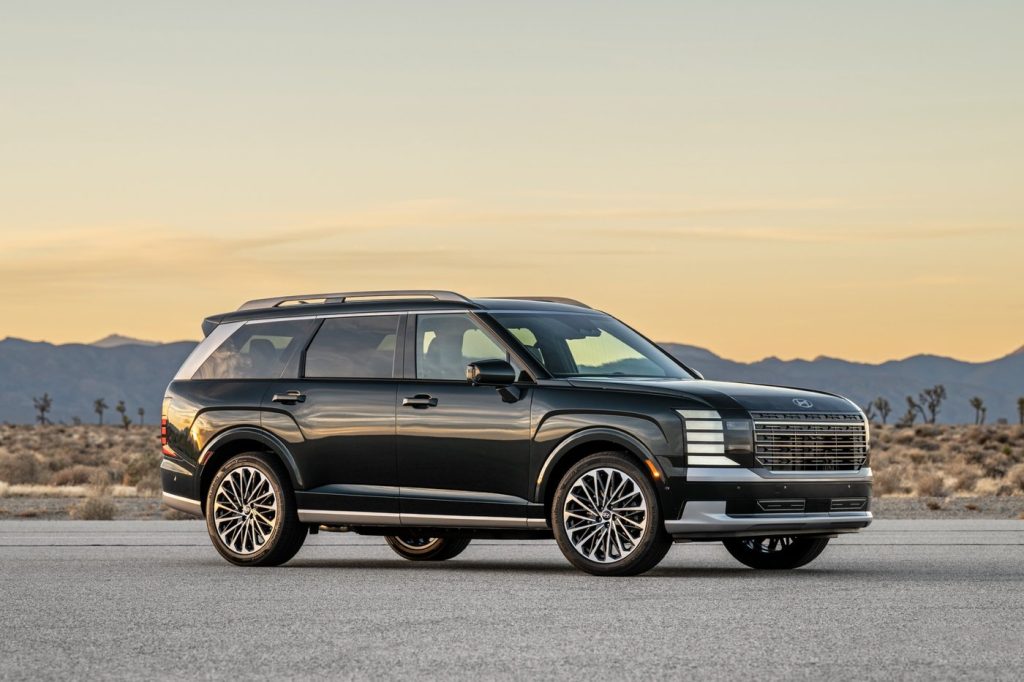Technology
Hyundai Palisade vs Kia Telluride: A Comprehensive SUV Showdown

The automotive landscape is shifting with the arrival of the redesigned 2026 Hyundai Palisade, which features updated styling, new engines, and enhanced technology. As this new model prepares to hit the market, consumers must consider whether to opt for the fresh Palisade or the well-established 2025 Kia Telluride. Both vehicles have been popular choices in the three-row SUV segment, and a recent comparison by Edmunds sheds light on their strengths and weaknesses.
Price and Features Comparison
Pricing plays a significant role in the decision-making process. The 2026 Palisade starts at $41,035, which includes the destination fee. In contrast, the 2025 Telluride has a lower starting price of $37,885. Both models come equipped with standard features such as eight-passenger seating, LED headlights, and a 12.3-inch touchscreen that supports Apple CarPlay and Android Auto integration.
While the Telluride offers synthetic leather upholstery as a standard feature, enhancing its premium feel, the Palisade justifies its higher price with additional conveniences. These include wireless smartphone connectivity, front and rear parking sensors, and automatic braking capabilities while reversing. At the high end, the Telluride SX-Prestige is priced at $52,885, while the top-tier Palisade Calligraphy costs $56,160. Buyers pay a premium for the Palisade, which includes unique features like a massaging driver’s seat and integrated dashcams for recording video.
Engine Performance and Fuel Efficiency
Under the hood, the 2026 Palisade introduces two new engines. The standard 287-horsepower V6 yields an estimated 21 mpg in combined city and highway driving. Additionally, a turbocharged four-cylinder hybrid engine producing 258 horsepower joins the lineup, although fuel economy estimates for this variant are currently unavailable.
In comparison, the 2025 Telluride features a 291-horsepower V6 that achieves up to 22 mpg combined. In testing conducted by Edmunds, the Telluride reached 60 mph in just 7.5 seconds, showcasing its competitive acceleration. The Palisade, burdened by an additional 400 pounds, took about 8.8 seconds to achieve the same speed, making it one of the slower options in the three-row SUV category.
Interior Comfort and Cargo Space
Comfort levels in both SUVs are commendable. The Palisade is noted for its quiet cabin and smooth ride, effectively absorbing road imperfections. It offers considerable headroom and legroom across all three rows. The Telluride matches these comfort levels but the Palisade’s enhancements give it a slight edge.
When it comes to cargo capacity, the Palisade can hold 19.1 cubic feet behind its third row and 46.3 cubic feet with the third row folded down. Folding both the second and third rows creates an impressive 86.7 cubic feet of total cargo space. The Telluride boasts slightly more cargo space on paper, yet the difference is not significant enough to impact everyday usability.
In summary, the new second-generation Palisade refines an already strong contender in the three-row SUV market. While its recent updates give it an advantage, the Kia Telluride is expected to receive a redesign that may level the playing field. For now, prospective buyers face a compelling choice between the refreshed Palisade and the dependable Telluride.
This analysis was provided by Edmunds and contributed to by Dan Frio of The Associated Press.
-

 Education3 months ago
Education3 months agoBrandon University’s Failed $5 Million Project Sparks Oversight Review
-

 Science4 months ago
Science4 months agoMicrosoft Confirms U.S. Law Overrules Canadian Data Sovereignty
-

 Lifestyle3 months ago
Lifestyle3 months agoWinnipeg Celebrates Culinary Creativity During Le Burger Week 2025
-

 Health4 months ago
Health4 months agoMontreal’s Groupe Marcelle Leads Canadian Cosmetic Industry Growth
-

 Science4 months ago
Science4 months agoTech Innovator Amandipp Singh Transforms Hiring for Disabled
-

 Technology4 months ago
Technology4 months agoDragon Ball: Sparking! Zero Launching on Switch and Switch 2 This November
-

 Education4 months ago
Education4 months agoRed River College Launches New Programs to Address Industry Needs
-

 Business3 months ago
Business3 months agoRocket Lab Reports Strong Q2 2025 Revenue Growth and Future Plans
-

 Technology4 months ago
Technology4 months agoGoogle Pixel 10 Pro Fold Specs Unveiled Ahead of Launch
-

 Technology2 months ago
Technology2 months agoDiscord Faces Serious Security Breach Affecting Millions
-

 Education4 months ago
Education4 months agoAlberta Teachers’ Strike: Potential Impacts on Students and Families
-

 Education4 months ago
Education4 months agoNew SĆIȺNEW̱ SṮEȽIṮḴEȽ Elementary Opens in Langford for 2025/2026 Year
-

 Science4 months ago
Science4 months agoChina’s Wukong Spacesuit Sets New Standard for AI in Space
-

 Business4 months ago
Business4 months agoBNA Brewing to Open New Bowling Alley in Downtown Penticton
-

 Business4 months ago
Business4 months agoNew Estimates Reveal ChatGPT-5 Energy Use Could Soar
-

 Technology4 months ago
Technology4 months agoWorld of Warcraft Players Buzz Over 19-Quest Bee Challenge
-

 Business4 months ago
Business4 months agoDawson City Residents Rally Around Buy Canadian Movement
-

 Technology2 months ago
Technology2 months agoHuawei MatePad 12X Redefines Tablet Experience for Professionals
-

 Technology4 months ago
Technology4 months agoFuture Entertainment Launches DDoD with Gameplay Trailer Showcase
-

 Top Stories3 months ago
Top Stories3 months agoBlue Jays Shift José Berríos to Bullpen Ahead of Playoffs
-

 Technology4 months ago
Technology4 months agoGlobal Launch of Ragnarok M: Classic Set for September 3, 2025
-

 Technology4 months ago
Technology4 months agoInnovative 140W GaN Travel Adapter Combines Power and Convenience
-

 Science4 months ago
Science4 months agoXi Labs Innovates with New AI Operating System Set for 2025 Launch
-

 Technology4 months ago
Technology4 months agoNew IDR01 Smart Ring Offers Advanced Sports Tracking for $169










